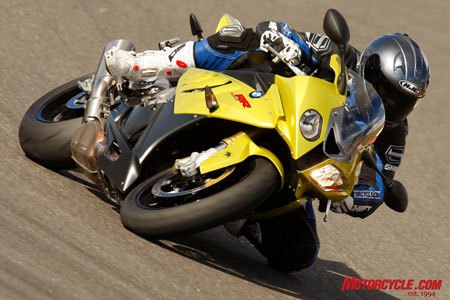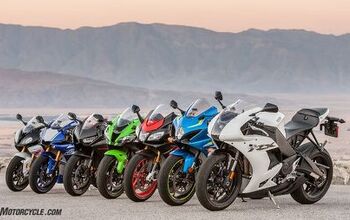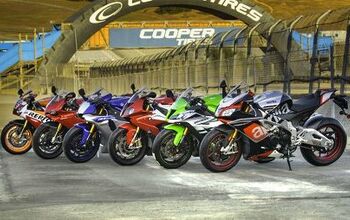2010 BMW S1000RR Review - Motorcycle.com
Get the Flash Player to see this player.
BMW Motorrad hits the literbike market hard with its race replica, as the S1000 employs class-leading power, a stout chassis beyond reproach, and a techie electronics package second to none. This bike is the real deal.
We've been teased with details of the bike for well over a year. Our first glimpse came in April of 2008 when I wrote the S1000RR Preview, and then we brought new insight last December in our Closer Look article. Then we finally got to see the bike in the flesh at its U.S. introduction where Pete elaborated on the RR's features and specs.
After all of that, we were already quite up to speed on what the bike consists of. Now all we needed to know is how it performs.
Morning at Portimao
Rolling into the Autodromo Internacional do Algarve in Portimao, Portugal, its extreme elevation changes promise an entertaining day, even if we weren't to ride one of the most anticipated sportbikes to come along in years. .
The base S1000RR retails in America for $13,800, but the bikes we'd be riding were equipped with BMW's optional electronic rider aids. As with 98% of S1000RR pre-orders, our bikes had the $1,480 traction control and Race ABS option, plus the $450 Gearshift Assistant that allows full-throttle upshifts without backing off the throttle or using the clutch. The only thing missing from a fully optioned RR is the white, red and blue BMW Motorsport color, a $750 option that has been selected in about 50% of pre-orders thus far. The test bikes were flavored in a unique Acid Green Metallic, but other color choices include a classy Mineral Silver Metallic or a sinister Thunder Grey (black) Metallic
Advanced technology features heavily on the S1000RR. Base models include electronics that influence power and throttle response over four possible modes: Rain, Sport, Race and Slick. It's simple to select while stationary, but they can be changed even while riding. A press of the nicely damped right-side switchgear selects the desired mode, then you have 60 seconds in which to close the throttle and pull in the clutch which triggers the new mode you've chosen.
The Dynamic Traction Control/ABS option (either of which can be disabled if desired) adds to the four riding modes a few other rider aids, including varying ABS settings and a form of wheelie control. Wheel-speed sensors supply info for the ABS and traction control, and a gyro mounted under the seat provides additional data to the bike's ECU to influence throttle response and to provide a measure of wheelie control.
Instrumentation is robust. An analog tach features prominently, with LCD displays for speed, an easily read gear indicator, and an adjustable (for both brightness and frequency) shift light. Lap times can be logged by engaging the high-beam flash trigger or by a trackside beacon and can display last lap time, best lap, number of laps, accelerator position in percentage per lap, time per lap the brakes were applied, minimum and maximum speeds and the number of gearshifts. Whew!
Session One – Rain Mode
As we were learning a new bike and a new track, we were advised to begin with the ECU set to the Rain mode. This smooths throttle response and limits engine output to a maximum of 150 horsepower. And with the DTC/ABS option, it also restricts throttle application at lean angles greater than 38 degrees; making it ideal when riding on low-adhesion surfaces.
However, on a dry and grippy racetrack like Portimao, the system proved way too intrusive. Especially off-putting was the ghost in the machine that prevented application of throttle when at a corner's apex while the bank-angle sensor was beyond the 38-degree threshold. Then, once at 37 or fewer degrees, power comes on suddenly and gives the pilot the feeling that he's not fully in control.
Still, there was much to appreciate from this restricted first session. BMW's RR feels as nimble as a Honda CBR1000RR, the most agile of existing literbikes, and it continues steering well even while trail-braking. It feels lighter than its fully fueled 450-pound weight would indicate. Ergonomics feel racy but not brutal, with pegs set back quite far.
Although the engine is detuned in Rain mode, there is still plenty of power on tap. BMW's RR has the largest bore (and, correspondingly, shortest stroke) of its competition, and this usually hinders low-end and midrange power. BMW fills in those low-rev holes with technologies that alter the flow of air in and out of the engine.
On the intake side are variable-length throttle trumpets, using a longer, torque-enhancing configuration at lower revs before splitting apart to reveal a short intake runner for maximum power at high rpm. Spent gasses are at the mercy of three exhaust valves. A butterfly valve bridges the header tubes of cylinders 1 and 4, and a second butterfly joins cylinders 2 and 3. A third exhaust valve located ahead of the tailpipe is described by BMW as an “acoustic flap,” which is in place only to limit sound emissions at lower revs.
Session Two – Sport Mode
It only took a few corners to realize the Sport setting is much preferable in dry, high-traction settings than the Rain mode. Throttle response is still smooth and the bank-angle sensor is still in play, but in Sport mode it only limits throttle openings at lean angles beyond 45 degrees. Within these parameters, a rider is still able to cut fairly quick laps
Without the Rain setting's restriction of power output, the S1000RR is able to unleash its full 193 claimed crankshaft horsepower, although throttle application is more progressive than the Race or Slick settings. Full-throttle acceleration is something near ferocious, and I'd estimate a rear-wheel horsepower number near 170, which would make the S1000RR the most powerful literbike available.
In its spec chart, BMW states the S1000's maximum speed is “over 200 kph,” which is a bit of a joke because the uber-sport Beemer was carrying its front wheel up the front straight beyond 240 kph – that's 150 mph to us Ah-mer-cans. Peak torque of a brawny 82.6 ft-lbs arrives at 9750 rpm, while 193 ponies are bolting the corral at 13,000 rpm, 1200 revs short of its lofty rev limit.
A limitation of Sport and Rain modes is a form of wheelie control based on wheel-speed sensor data. If acceleration forces the front tire off the ground, it soon will be spinning slower than the rear. The ECU perceives this data as a loss of traction, and the DTC cuts power and therefore brings the front wheel back in contact with the tarmac, sometimes ungracefully.
In the lower gears where acceleration is strongest, a rider can be presented with a wheelie followed by a fairly aggressive intervention of power, then, once wheel speeds are equalized, full power resumes that can again initiate another wheelie and another power interruption. Disabling the DTC prevents such histrionics.
Another rider aid, this one based on the Race ABS, is present in Rain and Sport modes. If the ABS senses the rear wheel is lifting off the ground during hard braking, it will subtly release a bit of front brake pressure to bring down the rear end, an operation that is transparent to the rider. .
Session Three – Race Mode
Stefan Zeit, Project Manager for the S1000RR, says Race mode is best for 90% of trackday riders. It offers more aggressive throttle inputs, nearly the one-to-one ratio of Slick mode. A rider is aware of the higher state of tuning by throttle response that is occasionally but not always slightly abrupt upon reapplication.
The DTC in Race mode allows 48 degrees of lean before affecting throttle application, and that's a fairly deep angle of dangle for most riders. Even with excellent grip from the standard-equipment Metzeler Racetech K3s, the DTC is reassuring and really aids confidence on corner exits. This higher-performance mode also enables bigger wheelies before power is reduced.
The parameters of the Race ABS is also geared toward faster riders in the Race mode, so the rear-wheel lift-off detection is disabled. I'm happy to report the S1000RR has very little of the oft-maligned pulsing feel of some anti-lock systems. Only a few times while bleeding off 170 mph into Turn 1 did I feel any mediation of the ABS. Kudos to BMW for building such a clever system that adds only 5.3 pounds to the bike. The performance anti-lock system on Honda's CBRs add 22 pounds of ballast to its RRs.
Speaking of rider aids, it was a pleasure to be turning laps with the help of BMW's Gearshift Assistant. The quickshifter simplifies upshifts by briefly cutting the ignition to enable grabbing the next gear without using the clutch or letting off the gas – seamless acceleration is available by simply kicking the foot lever. It makes a squeaky-squooshy sound faintly akin to a turbo's wastegate letting off excess boost
Session Four – Slick Mode
You gotta be serious if you want to get into Slick mode – you can't even access it unless it is enabled by an optional accessory to plug into an underseat port. The “Slick” part refers to racing tires, not traction.
Slick mode allows 53 degrees of lean angle before throttle application intervention, and you've got to be a moderately heroic rider to be demanding more power while leaned over at, say, 55 degrees. If you are that person – perhaps factory BMW rider Troy Corser – you're free to disable the DTC with a long push of a single button.
Slick mode also allows access to wheelies without disabling the DTC, but there are still a couple of electronic nannies in place to keep a rider safe. Mono-wheeling remains verboten if the bike is at a lean angle greater than 23 degrees, and the duration of a wheelie is limited to five seconds of fun before the electronic cops are called in to spoil the party. If wheelies are a prerequisite in your hooligan world, simply turning off the DTC will enable your Jason Britton imitations.
One other noteworthy trait of Slick mode is that the rear brake loses its anti-lock control so your inner Ben Bostrom can pull hackers on corner entries. Truth be told, I barely remember even using the rear brake. The Brembo radial-mount front calipers and 320mm floating front rotors are deliciously powerful, exhibiting exemplary feel through steel-braided lines without a harsh initial bite.
I spent the rest of my day in Slick mode, as it was the closest comparison to the literbike rivals without disabling the traction control entirely. Positive impressions were plentiful.
First off, I was amazed at the grip and durability of the Racetech K3s. Good front-end feel and feedback through the beefy 46mm inverted fork inspired confidence, and the S1000 needed to be ridden quite aggressively before I could get the footpeg feelers to skim the pavement. Corner entries are aided by a back-torque-limiting (slipper) clutch that performed well.
Not a lot of time has passed since the recent construction of the Portimao circuit, so there weren't many bumps on which to test the S1000's fully adjustable suspension. As set up, it performed perfectly, and we award BMW kudos for giving each compression and rebound damping adjuster clearly labeled numbers from 1 to 10 to simplify keeping track of your settings. Front and rear ride heights are also adjustable.
Multiple trips to the S1000's redline gave plenty of opportunities to sample the characteristics of BMW Motorrad's highest specific-output engine ever, and I was surprised the non-counterbalanced engine didn't give off objectionable vibration at any speed. Christian Landerl, Executive VP Development and Model Lines, BMW Motorrad, told us it was because of the engine's lightweight components and the particular frame design.
Landerl, who began work on this project nearly five years ago, pointed out the Formula 1-influenced valvetrain that uses finger followers made of forged steel and treated with DLC to toggle the four titanium valves per cylinder – many engines with Ti poppets use steel valves on the exhaust side. Landerl claims the S1000's design allows valve actuation components to be 30% lighter than a conventional shim-under-bucket design, key to the high 14,200-rpm redline. Landerl says it could safely rev to 15K. As it is, the S1000 has fairly lengthy 12,500-mile valve adjustment intervals.
A View From The Paddock
David Robb, BMW's VP of Motorcycle Design, is a man accustomed to critiques of his innovative and somewhat unusual styling touches, often characterized by asymmetry like the headlights of the successful R1200GS. The S1000RR exhibits this somewhat peculiar element, seen most clearly in the headlights that some have described as “a winking pirate.”
The fairing's sidepanels also don't match. The duct in the left side fairing panel does the bulk of the work to vent heat generated from the radiator and engine, so much so that it was determined that the same design wasn't needed on the other side. Instead, the right side features a distinctive gill pattern
I was among those who was dubious of Robb's design when I first saw it in photos, but I've become a fan after seeing it in the flesh under many different lighting conditions. It is a compact, aggressive and purposeful design, with several smaller elements providing additional eye candy.
The black-anodized aluminum frame is nicely sculpted, and Robb says he went through about 47 frame designs before all performance and packaging requirements were met. My favorite component, looks-wise, is the brawny aluminum swingarm that is as cool as anything on the market. Thin-spoke wheels look and are lightweight. A large under-engine silencer box with a catalyzer allows a more fashionable stubby muffler than we've seen from several other manufacturers.
The Verdict
Purists might decry the litany of electronic rider aids available on BMW's first ultra-sportbike, but it's notable that not a single S1000RR hit the ground after two launch waves and some 80 journalists – even the Brits and Italians, who have a reputation for bending bikes, remained unscathed.
We applaud the way BMW has incorporated the electronics into the S1000, as the selectable modes essentially provide four motorcycles in one. And if you're too cool for DTC or traction control, they can be switched off with a push of a button.
I wasn't the only journalist at the launch who was highly impressed with BMW's new supersport literbike. It's devastatingly powerful yet easy to manage, and its electronics package is more advanced than anything from its rivals. It's also a responsive handler, its brakes are as good as they get and have the added safety benefit of ABS. I can't really think of any single thing it lacks.
Here's some perspective: The most annoying aspect of the bike was its sidestand's lack of a tang, making it mildly difficult to deploy with a race boot!
It's safe to assume that the Berlin-built S1000RR is going to blow away perceptions of BMW motorcycles, not the least of which is an MSRP that is only slightly higher than the Japanese competition.
“In my opinion, it's the most important product launch in our 85-year history,” Pieter De Waal, VP of BMW Motorrad USA, told Motorcycle.com.
De Waal added that BMW is only looking to nab about 10% of the lucrative literbike market. And if it doesn't?
“If it doesn't sell in high volume, you can probably talk to my successor to ask more questions,” he joked.
Related Reading
2010 BMW S1000RR – First Ride
BMW S1000RR U.S. Debut
2009 BMW S1000RR World Introduction
2009 BMW S1000RR – A Closer Look
2009 BMW S1000RR Preview
2009 BMW S100RR Entering Production
BMW S1000RR at Nurburing (Video)
2010 BMW S1000RR Price Speculation
S100RR Forum
All Things BMW on Motorcycle.com
More by Kevin Duke











































Comments
Join the conversation